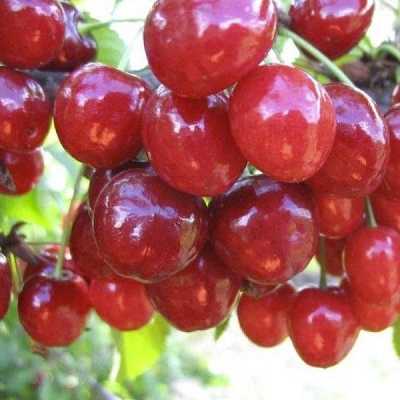
- Appeared when crossing: Vladimirskaya early cherry x Winkler white cherry
- Barrel type: wood
- Growth type: medium-sized
- Crown: pyramidal
- Leaves: matte, dark green, very large, obovate
- Fruit size: large
- Fruit size, mm: height 25 mm, width 30 mm
- Fruit shape: onion
- Fruit color: light pink
- Fruit weight, g: 8-10
Hybrids are not so popular with summer residents, as some do not know exactly how to care for the crop. But many would like to try these varieties. Hybrid duke Krasa Severa is distinguished by unpretentious care, good harvest and pleasant berry taste.
Breeding history
Duke is a hybrid that appears by crossing cherry and sweet cherry. The beauty of the North appeared in 1885, when the early Vladimir cherry blossomed (some gardeners know this cherry as Beli). Its buds were pollinated with pollen from Winkler's white cherry. Test work took place in the years 1883-1884. The first berries were pure white, without much admixture, but gradually the shade of the fruits began to change slightly, and a pink tint appeared.
Description of the variety
The height of the tree reaches 2.5-3 m, but in the southern regions the trunk can stretch up to 4-6 m in length. The culture is classified as a medium-sized varieties. The crown is pyramidal in shape. If molding is not carried out in time, the branches will begin to grow chaotically, and the pyramidal shape will begin to change to spherical or oval.
Skeletal branches are very strong and massive, dark brown in color, diverge from the main trunk at an angle of 60 degrees.
There are many leaves. They are large, obovate in shape, reminiscent of cherry. The surface is matte, dark green. The petioles are long, and the edges are slightly pointed. There are also jagged edges along the edges.
The buds begin to bloom in late May or early June. In the southern regions, flowering occurs in April.
The originators note that the Krasa Severa duke took only positive qualities from his parents. The culture has rather high immunity indicators, in particular to diseases such as coccomycosis and moniliosis. The plant adapts well in cold regions and can easily survive temperatures as low as -26 ° C. Fruiting is abundant and annual.
Among the minuses, it is noted that the variety has a fast growth. Shoots grow vigorously and stretch out quickly. If the tree is not rationed, then a strong thickening will occur and the harvest may suffer. Since the hybrid is self-fertile, it is necessary to select pollinating varieties.
Fruit characteristics
The berries are large, bulbous in shape, with parameters 2.5 cm in height and 3 cm in width. Fruit weight - 8-10 g. There are also berries of 12 g. Color is light pink. The skin is smooth, glossy and shiny with a slight bloom. It is also very elastic. The pulp is yellow, juicy, fleshy and firm. The secreted juice is light.
The stalk is thick and long (up to 4.5 cm), well attached to the berry. Therefore, it is not always possible to easily pluck the fruit, due to which the variety is not so often attacked by birds.
The stone is medium, light in color. It is noted that the seeds, even in ripe fruits, are underdeveloped, so a new tree cannot germinate from them. This is a property of all hybrids. The separation from the pulp is easy, without a strong release of juice.
Taste qualities
Sweet notes are inherent in the Krasa Severa variety.There is also a sour aftertaste, but it is more refreshing than unpleasant.
Ripening and fruiting
The first harvest occurs 3-4 years after planting. In terms of ripening, the culture belongs to early maturing varieties. The fruiting period falls in the first weeks of July. The berries ripen at the same time.

Yield
High yields are directly dependent on proper care. 15 kg are removed from one tree, maximum - 20 kg of fruits.
Self-fertility and the need for pollinators
Duke Krasa Severa is a self-infertile variety, therefore it is necessary to plant pollinating varieties next to it. Hybrids, by their very nature, cannot become pollinators. Therefore, you need to select varieties of cherries or cherries with the same flowering period.
You can choose among the varieties:
- Lyubskaya;
- Bulatnikovskaya;
- Donetsk;
- Backyard;
- Annushka;
- Iput.
Landing
Hybrids, like other varieties of cherries or cherries, love neutral acidity. Excess moisture has a detrimental effect on the roots and the crop itself.
The selected area should be sunny and free of drafts. The place is prepared 2 weeks before planting the seedling. A hole is dug out with a depth of 60 cm, and its diameter is about 70 cm. It is recommended to mix the raised earth with humus, woody hall and superphosphate.
For a day, the seedling is dipped in roots into a weak solution of potassium permanganate for disinfection. Can be sprayed with special growth stimulants.
Pebbles are poured into the hole and sprinkled with earth. Then a peg with a length of 80-90 cm is installed. The seedling is carefully lowered into the ground, straightening the roots and sprinkling it with soil. The root collar should protrude 3-4 cm above the ground level. After compaction of the soil, everything is plentifully spilled with 2-3 buckets of water.


Growing and care
Duke maintenance does not require any expenses. It is important to complete the assigned tasks on time, and then the harvest will be large and good. They consist in:
- regular watering (20-40 l);
- loosening, weeding and mulching;
- top dressing;
- crown formation;
- preventive spraying;
- preparing for winter.


































































